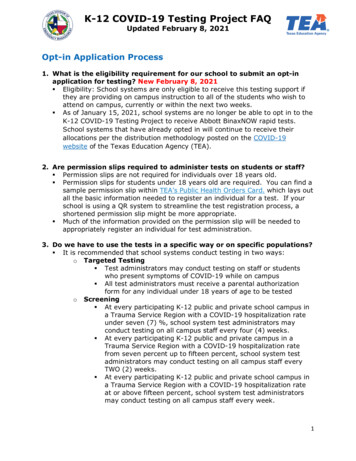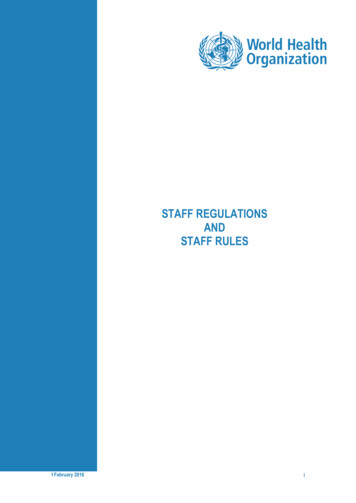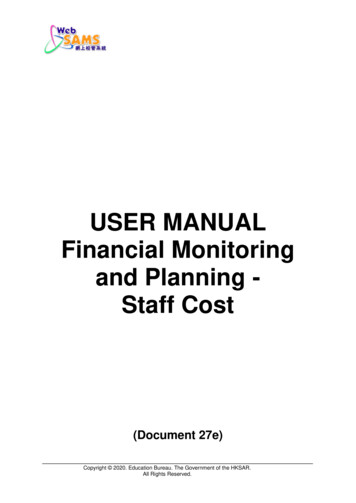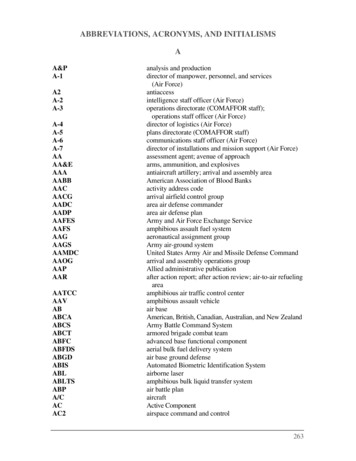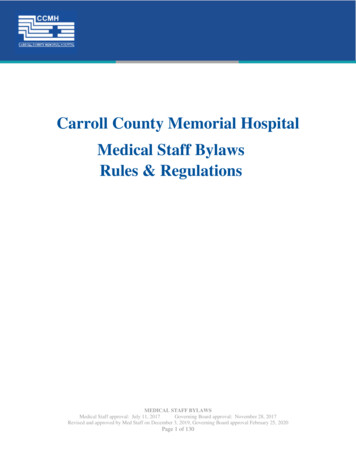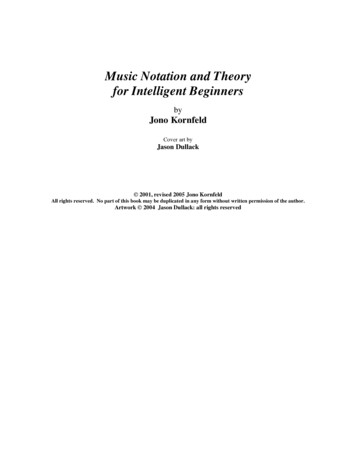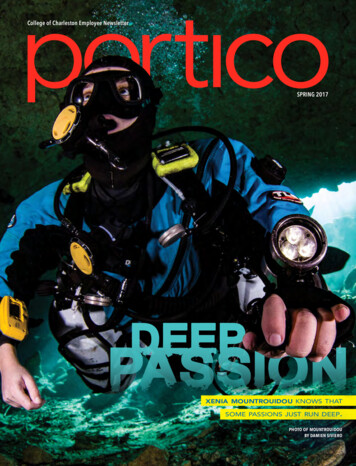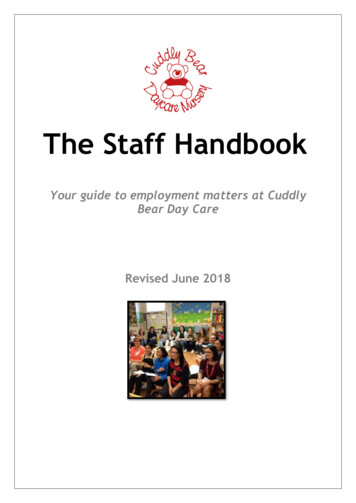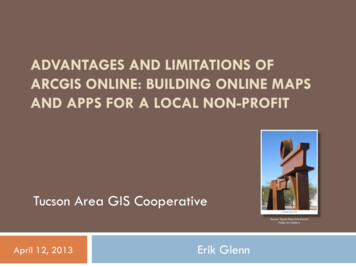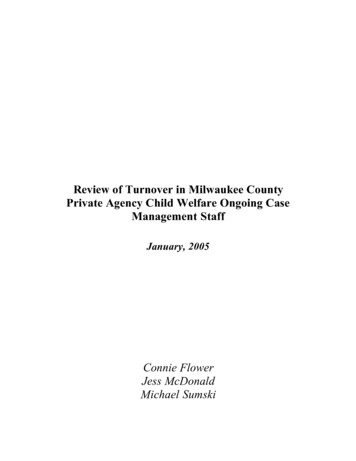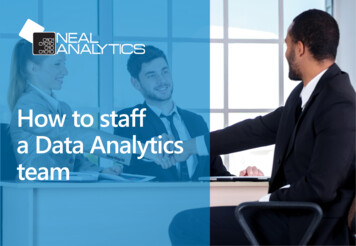
Transcription
2 How to staff a Data Analytics teamData-driven businesstransformationinitiatives requirespecific digitaltransformation skillsthat are hard to findThe needs for theseskill sets evolvethroughout the courseof the projectimplementation andmay not be necessaryat every stageIn most cases, up to80% of a data analyticsproject is going to beabout consolidating andpreparing the dataLeveraging externalresources is oftenthe fastest, mostcost-effective, andlower risk way to goHow these resourcesare managed andintegrated, short or longterm in your existingteam, is also anessential element
3 How to staff a Data Analytics teamIn this eBook, we share insights on how toenable, accelerate and eventually manageyour data initiatives successfully by leveragingspecialized outside resources, such as NealAnalytics expert consultants, to kick-start,complement, or augment an internal team.In 2011 Neal Analytics developed a leadinginnovative analytics delivery approach backed byits highly skilled experts, that successfully helpscompanies in various industries convert data andservers into visible and usable business results.Neal Analytics calls this Flagship resource theManaged Capacity model. It enables NealAnalytics to meet its customers’ needs withgreater speed and efficiency.But, before diving into the specifics of theconsulting engagement models (the “how”),let’s review the digital transformation steps (the“why”), and the roles and skill sets (the “who”).
4 How to staff a Data Analytics teamWhat are the steps in a digital transformation initiative?Typical digital transformation phases1BusinessAnalysis2Data EstateCreation3Data-DrivenInsightsLet’s go through each of these in more detail4Transformation
5 How to staff a Data Analytics team1Business AnalysisA successful digital transformationstarts from the business, not thetechnology.It is critical to identify where andhow deep this transformationneeds to happen before anydiscussion starts about whichcloud platform to use, what datastrategy to adopt, what regressionmodel to leverage, and whether atraditional machine learning (ML)model or a deep learning (oftenassociated with AI itself) one ismore appropriate.Then business needs will drivethe technology choice. Not theother way around.For instance, in a projectin the healthcare industry, NealAnalytics’ business consultantsworked with the customer’sexecutive team to identify morethan forty potential businessprocesses that could benefit fromdigital transformation.There are many types of businessdrivers behind selecting whichinitiative is the optimal target.Potential initiatives often fall in acontinuum mapped across multiplecriteria such as: Is the initiative for an existing or newbusiness process? Is it about reducing costs? Doingdigitally what is now analog, such asreplacing manual data entry withoptical character recognition – akaOCR), or creating new revenues? What level of risk and change isappropriate? Is the team, group, or division thatwill help build, implement, and usethe initiative outcome ready forchange?In the example above, usingNeal Analytics methodology, thecustomer selected three projects toimplement initially out of the morethan forty possible ones.
6 How to staff a Data Analytics team2Data Estate CreationOnce the initiative goals and scope have beendefined, the bulk of the work will be in acquiring,consolidating, refining, and cleaning the data.Often, customers overestimate data availabilityand cleanliness and underestimate the amount ofwork needed to build a reliable data platform uponwhich insights can be derived.This is why new integrated Customer Data Platforms,such as Microsoft’s Dynamics Customer Insight, aregaining in popularity, and why the bulk of data projectwork falls into the category of data engineering.In our experience, the work data architectsand engineers need to perform before a datascientist can start building a solution to generatevaluable insights typically represents 80% of thetotal project effort.Countless times, an initiative that began as a datavisualization one based on existing data and aPowerBI dashboard turns out to require significantdata engineering and data governance work, whichitself requires knowing the business priorities.Often, data visualization initiatives end up exposingdeeper data quality issues and data processingproblems that end up creating an iterative dataengineering cycle of re-work.
7 How to staff a Data Analytics team3Data-Driven InsightsOnce the data platform isoperational, data scientists canstart building analysis reports,ML and AI models, and otherwisevalue-added insights to deliverbusiness value.require hundreds of thousands ifnot millions of labeled data points)and business problems, other,more straight forward models, canoften be faster, cheaper to build,and more effective.At this stage, it’s essential to avoidfalling into the buzzword trap.A customer might think that adeep learning-based model (i.e.,using neural networks, aka AI) isthe appropriate one.Frequently, simple statisticaltechniques (that also have thebenefit of requiring less data) areall that is needed to realize ameasurable business outcome,as an organization builds towardsa more resource consuming AIsolution.However, depending on theavailable data (most AI modelsTo select the right approach andmodel, customers need to haveaccess to a range of experts withcomplementary skills andexperience.It’s important to remember that,here as well, “for a hammer,everything looks like a nail.”Only by having access to a teamwhich understands when andwhere to use a technique can theyselect the right one.
8 How to staff a Data Analytics team4TransformationWhether it’s automated, withresults from these insights beingdirectly fed through automationinto business processes, or manual,with people using these insights toinform business decisions, this laststep is an important decision forany company deciding to gothrough digital transformation.Both the manual and automaticapproaches can be useddepending on the specificuse case.For engaging with people, thereare tools like Microsoft’s PowerPlatform that enables datavisualization-based (Power BI), orline-of-business application-based(PowerApps), or virtual agentbased (Power Virtual Agents).Transformative insights can alsobe connected to an automatedprocess such as (Power Automate)or included as the processproceeds through its system ofrecord (e.g. with the Dynamics 365platform). For instance, a real-timemarket analysis can be connecteddirectly into an ERP to adaptproduction schedules ahead ofmarket changes.In both the manual and automatedscenarios, these insights can oftenbe used to help select or refine thebusiness processes to improve(step 1 on page 4) and to identifythe missing, redundant, orinsufficient data that would enableeven better models.The iterative nature of theseproblems and their solutions iswhy CI/CD (continuousimprovement/continuousdevelopment) and iterativesoftware development processeshave become increasinglyimportant.To most effectively execute thisiterative process, you need aunique team and organizationalmethodology.
9 How to staff a Data Analytics teamWhat types of profiles arerequired for a typicaldata analytics project?The level of complexity in data analytics froma team, skills, and knowledge perspective varyper project, but as our experience shows,often leads to recurring patterns of needs.Through our many engagements, we havebeen able to build a set of standard patternsof operational excellence to serve ourcustomers best. One of these patterns is thetype of roles necessary throughout a project,depending on its stage.
10 How to staff a Data Analytics teamThe 6 stages of aData Analytics Project1OpportunityDiscovery2Data PipelineManagement34ModelizationWithin the CI/CD process, a technical team typicallygoes through 6 stages in supporting the digitaltransformation journey.Depending on the stage in the CI/CD process, theteam’s composition needs to be adapted. The diagramon the next page describes when each team memberwill play a role at any given stage in the process.Note: The team members on the next page are representational.Some projects may require only 50% of a data scientist’s time,while others may require a team of three or more.Reportingand Embedding5Operationalization6Evaluation,Decision & ActionTo illustrate how the team composition will evolve,let’s look at the business analyst role for example.The business analyst will carry the bulk of the work inthe initial discovery phase. When the project moves onto the data pipeline management stage, their workloadwill decrease, while the project manager or dataengineers will increase theirs.Similarly, data scientists will start to engage in theproject when the data pipeline management step isalready well underway but will ramp up to carry mostof the project load in the data modeling phase.
11 How to staff a Data Analytics teamProject lifecycle and resources aligned by stage12OpportunityDiscoveryData PipelineManagement34Model CreationReportingand Embedding5Operationalization6Evaluation,Decision & ActionBusiness AnalystCloud and Data ArchitectProject ManagerDatabase AdministratorData EngineerDatabase DeveloperData ScientistApp DeveloperIT Systems AdminPlatform EngineerCustomer business end-userCustomer Subject Matter Expert/End user
12 How to staff a Data Analytics teamRoles & Responsibilitiesin a Data AnalyticsProjectLet’s drill down a bit further intowhat those roles entail from abackground and deliverablesperspective.
13 How to staff a Data Analytics teamTypically a business analyst will combine the understanding of business processes andgoals and knowledge of the possible technical solutions at a functional level.What is theBusiness Analyst’s role?This senior-level profile showcases a substantial business experience, most likely arecognized business degree such as an MBA or equivalent experience and is technologysavvy.They will drive the process form the ideation step, to the scenario selection, to the finaldata analysis and overall project reporting to the customer.What is theArchitect's role?What is theProject Manager’s role?Architects define how the different pieces of software fit, work, and function togetherwithin the scope of a project.They typically have experience in software development and, likely, a recognizedtechnology degree such as a degree in computer science.The project manager will drive the planning, forecast, and ultimate delivery of the project.They are familiar with Agile software development methodologies and usually have botha business and technical background.The project manager is the glue that will remain the driving force throughout the projectas other team members ramp up and down.Depending on the project complexity, a project manager typically manages no more thanthree to five projects in parallel. For large projects, the project manager can be occupiedfull time and may require the help of junior project managers.What is a DatabaseAdministrator’s role?Database administrators provide the backbone of database system functionality.They ensure that the databases run smoothly, optimize and tune systems, and assistwhen issues occur and troubleshoot and bug-fix problems.
14 How to staff a Data Analytics teamWhat is aData Engineer’s role?What is a DatabaseDeveloper’s role?Data engineers are developers focused on data movement and transformation tasks,as well as the tools required to make these movements and transformations happen.Frequently, data engineers also engage in database specification, creating entityrelationship models or other specifications to create databases.Data engineers typically have a background in data development, knowledge of SQL,and a deep understanding of how data moves and interacts through different systemsand processes.Database developers are like data engineers, although they often have more specializedskill sets around a particular type of database development. Where data engineers areoften generalists specializing in tools like Java, Python, Scala, or cloud-native tools,database developers frequently specialize in different specific database types, like Oracle,Microsoft SQL, or other.Otherwise, these roles are similar, with a deep focus on data development, pipelinecreation, and modeling databases relationally.What is a DataScientist’s role?What is an ApplicationDeveloper’s role?A data scientist will transform data into insight. Using a portfolio of data analytics,machine learning, and other advanced AI techniques, the data scientist will build theknowledge engine that will power the transformation process.The application developer's role is to convert the insights coming from the data scientistsinto actions. By integrating these insights into dedicated or existing applications, whetherthese applications are part of an end-user workflow or whether they control a businessprocess (e.g., an ERP).In some situations, the app developer will build data visualization dashboards usingMicrosoft PowerBI or other tools that end-users will use to help make business decisions.
15 How to staff a Data Analytics teamWhat is an IT SystemAdministrator’s role?IT systems administrators are the generalists who keep an organizationfunctioning. They typically have working knowledge of all the company’ssystems and possess the skill set and tools to implement, and resolve issues.These resources are often tasked with “keeping the lights on” with cloudmanagement, security, office, email management, or other server-side adminfunctions.They typically have learned PowerShell or Linux and at least one other scriptinglanguage.What is a PlatformEngineer’s role?Platform engineers are IT systems administrators who’ve expanded theirsystems knowledge into the cloud.In addition to the skills described in the IT systems administrator jobdescription, platform engineers bring knowledge of how to scale up theirautomation to multi-machine level, using tools and platforms like Azure, AWS,Jenkins, Docker, VMWare, or others.Their specialized knowledge of platform systems enables them to harness thepower of whatever platform they are using for massively distributed computing.
16 How to staff a Data Analytics teamA data analytics initiative requires a broad set of skills, one thatevolves through the project, and with a team size that can vary quitesignificantly depending on the project.The final piece to fit these components together is an organizationalmodel to support the transformation goals associated with analytics.Some organizations wish to create internal centers of excellence,others want to only engage in fixed-term projects, while others wantto outsource the capabilities completely.To help execute the complex needs of data-driven initiatives, NealAnalytics offers a portfolio of engagement models. Each of theseengagement models has its own unique set of variables and benefitsthat allow Neal Analytics to fit its services best into its customerenvironments. These models will adapt to any customer’s needs andbusiness philosophy. They can also be mixed and matched dependingon where a customer is on their data journey.How to organizethe perfect teamfor a dataanalytics project?For more mature customers scaling an existing team through staffaugmentation is often the quickest way to engage.For customers who do not want to engage directly with or manageresources within this software development lifecycle, project-basedwork is often the best fit.For customers who wish to outsource or want a capable team ableto quickly and seamlessly plug into a broad analytics initiative,a managed capacity approach is often best.
17 How to staff a Data Analytics team1. Staff Augmentation(aka role-based staffing)Neal Analytics offers the traditional staff augmentationmodel. Our expert consultants can seamlessly integrateinto existing teams to complement or augment their skillset on a temporary or permanent basis.For instance, a company with a need for data sciencehelp to complement its existing team during a temporaryheavy workload, can add one or more data scientists to itsteam for a few months until it can go back to its businessas-usual mode.With teams present both in the United States in ourBellevue, WA headquarters, and in our Pune, India office,Neal Analytics can offer a range of staff augmentationoptions: onsite, offsite, or a blend of both.This engagement model tends to work best with maturecustomers who have a defined organizational model intowhich Neal Analytics adds complementary resources, andwell-defined business analyst initiatives where itsresources will add value.2. Project-BasedNeal Analytics also offers project-based work.Defined through a statement of work (SOW), whichencapsulates deliverables and timelines, a teamexpertly staffed for a project, will then beresponsible for the project’s delivery.Project-based work is often part of a functionalportfolio management initiative for a customer’sdigital transformation efforts. Customers interestedin building their team, but unsure of how to start,choose this option so they can see an alreadyfunctional team in action.Unfortunately, the disadvantage is that it’s thecostliest one on a per-resource basis. The upsideis that the vendor signs up to fixed deliverablesover an estimate.In our experience, as customers mature, they usuallyopt for staff augmentation or managed capacity as afollow-up to initial project-based work.
18 How to staff a Data Analytics team3. Managed CapacityNeal Analytics also offers its Managed Capacitymodel. It provides customers access to the optimalmix of skillsets throughout the engagement duration.It quickly allows the continuous and iterativedefinition of customers’ priorities, the creation of aregularly updated living document that describeswork in progress and targets for a given initiative,and allows scaling as the project evolves.This model brings the best of both the traditionalstaffing and project approaches into a predictable,reliable, flexible, and scalable framework.This model also leverages a modern engineeringapproach and a flexible team composition. It is oftenthe preferred engagement model for large orcomplex projects.
19 How to staff a Data Analytics teamThe ABC of Managed Capacity Engagements:AA fixed, but adaptable monthly retainerBBlended engagement teams whichcomposition adapts to the project needsCAn Agile software engineeringapproach using two-weeks sprintsto deliver predictable resultsA. ClearEngagement ModelMonthly retainerGrows/decreaseas neededB. AdaptiveTeam CompositionSizeSkill set mixManagedCapacityC. ModernEngineeringApproachAgile methodologyBest-practice reuseThese managed capacity engagements can be designed to be permanent, ongoing, outsourcedarrangements where the Neal Analytics team will operate a data-driven business process on behalfof the customer.
20 How to staff a Data Analytics teamA. Monthly retainerB. A project team with the optimalskill set mixThe client will either define an appropriatemonthly project retainer based on scopeand timeline constraints or, alternatively,calibrate its requirement (either timelineand scope or both) to fit a pre-defined,but adaptable, monthly retainer.Within this monthly retainer, Neal Analytics will put togetherthe optimal project team, based on the goals and project stage(as defined in steps 1 to 6 on page 10).By choosing this approach, the clientwill be able to keep its expenses predictable.If, for whatever reason, the project scopeincreases or decreases, customers will beable to adapt this retainer on a month tomonth basis.Depending on the stage and project, as low as 10% of aspecialist’s time can be associated with a project at a giventime, and as many as necessary can be added.This model is very flexible as the client doesn't need to stafffull-time specialists.Managed capacity teams, depending on the project, can beas small as three people equivalent to tens of specialists.
21 How to staff a Data Analytics teamC. Modern Software Engineering – Agile Methodology andBest Practice ReuseAlthough it has been used broadlyfor many years and often identifiedas “modern software engineering”,the common best practice, Agilemethodology, fits well with thecomplex, ever-evolving goals, andspeed of typical data analytics, AI orML projects.By focusing on short (typically twoweek) development “sprints,” it allowsthe managed capacity team to focuson the most critical and urgent tasksat hand across the six stages depictedon page 10.1PLAN5EVALUATE2DESIGNAgile softwaredevelopmentcycle4TEST3DEVELOP
22 How to staff a Data Analytics teamFor each sprint, the customer and theNeal Analytics project team will align onthe next sprint deliveries, whether theyare new features, bug fixes, or codeimprovements, such as speed, size,or reliability.After each sprint, the team will revisit thedeliverables post-mortem (Agile lingo),plan for future team compositionmodifications such as adding morespecific resources or reducing others, andplanning the next one (Backlog groomingor review).This ongoing cadence lets the NealAnalytics team plan for future workand build out a practical roadmap withclients towards mutual success.As the project reaches completion,an ongoing project retainer can ensurethe project is maintained, improved, andadapted as data and business conditionschange.Throughout these engagements, themanaged capacity team will operateusing standard best-practice patterns,templates, processes, and solutions NealAnalytics has already implementedmultiple times for other customers.This will help ensure both output qualityand engagement efficiency.
23 How to staff a Data Analytics team4. Managed ServiceThe managed service model is the classicalout-sourcing model.It enables a customer to outsource a full businessprocess and rely on a supplier, such as NealAnalytics, to operate the process without the needto invest internal resources.It can scale as needed and is often more costeffective for well-defined processes that are notcore to the business.
24 How to staff a Data Analytics team5. Build-Operate-TransfercombinationThese engagements can also be combined, as needed,in a Build-Operate-Transfer model.With this mixed model, the Neal Analytics team willmorph its engagement based on the project’s stageand customer needs.First, a skilled Neal Analytics team will build the initialsolution end-to-end (project or managed capacity).Then, Neal Analytics will operate the solution duringits initial production stages (managed service).Finally, the team that built and operated the solution willtrain the customer’s organization and transition the dayto-day operations to its in-house team, supplying it withstaffing resources as needed (staff augmentation),ensuring a smooth and seamless transition.
25 How to staff a Data Analytics teamConclusionAnalytics projects are seldom as straightforward as initially expected. Internally staffingan appropriate team to support them can bechallenging when no existing large-scale plan exists.For those interested in learning more about managingdata projects, here are a few relevant articles: MSDN Blog post from Buck Woody on the Team Data ScienceprocessDepending on the goals, timeline, and budgetaryand available skill set constraints, several optionsare possible. Neal Analytics offers a flexible approach to thesechallenges, building on years of experiencedelivering projects from business analysis to dataestate modernization, to analytics, machinelearning, and AI.Work in the purview of a data scientist typically falls into oneof two categories, with most data science jobs leaning one wayor the other, and this lifecycle is referred to as experimentationversus operationalization by Gartner We also suggest reading Gartner’s associated detailed articleand blog post There is an article from OpenView Partners a VC firmspecialized in the SaaS market: Why Your Data Science ToolHasn’t Made Machine Learning Easier (Yet) A webinar from the MIT and Cloudera on How to ScaleProduction Machine Learning in the EnterpriseCustomers can purchase these engagements viaMicrosoft AppSource, or by contactingNeal Analytics at contactus@nealanalytics.com.
26 How to staff a Data Analytics om425.822.233211911 NE 1st St. Ste 206 Bellevue, WA 98005
A data scientist will transform data into insight. Using a portfolio of data analytics, machine learning, and other advanced AI techniques, the data scientist will build the knowledge engine that will power the transformation process. Data engineers are developers focused on data movement and transformation tasks,
